

[BELOW:] MANTA OMEGA Side view, giving the classic FROST 1962 design's side profile. Tip plates at elevon ends were on the original. EPP underbody allows easy launch, resiliency on landings.


[ABOVE]: MANTA Rear view showing clear vertical stabilizer, elevons with end plates


John Frost's design of the later version of the AVRO Project Y 'Flying Saucer' type aircraft caught my interest- thanks for the information posted on the RC Groups discussion page (linked below). I'm presently referring to this particular design as the MANTA OMEGA, as it was possibly the last in the series of his designs, patented in 1962
I found two more photos this evening of an earlier prototype that may have been built, but supposedly never flew. Evidently, Frost left A. V. Roe [AVRO] when the USAF funding ended in 1961, so this may have been his last design version, patented in 1962 after leaving A.
The design drawn in his November 6th, 1962 patent, #3062482, looks like a fun design to build in a sytylized Bluecor / EPP version. I was inspired, & vert inclined to put one together to see how it could fly.... so I did!
[Another earlier Project Y design is part of the inspiration for my 'fantasy scale' Manta ACE, found at the end of this page. Click here to jump to the ACE design section.]
I've scaled the main template to 20" wide, 24" long, maximum 3-3/4" high/deep at the top of the cockpit. A clear fin / vertical stabilizer is incorporated. I built the lightweight flat plate wing version first, to get it in the air & flying.

[Above:] PROGRESS REPORT 11-23-2006: Bluecor wing & superstructure, EPP underbody (to give the sorta-scale side profile as well as structural rigidity & landing resiliency.) The clear .030 lexan polycarbonate sheet I have for the vertical stabilizer seems heavy, so balancing it will be an issue I'm keeping in mind; I may try to use thinner / lighter material. The Frost design also had some modest vertical stabilizers of the end of each elevon; these might be able to be enlarged (or overlaid with the clear extensions) to achieve adequate stabilizing effects.
I've wound up a GBv 1 motor with 15 winds of 24 gauge, Y termination; It'll fly something like an 8x4.3 to 8x6 prop on a 2S2P pack of the $.99 Li-I 850 mAH cells. Balancing is the final deciding factor on the pack used, and the 3 ounces of this pack will help for that.
Above is a look at my flat plate version of the John Frost 1962 design, previously referred to by someone as the "MANTA" ; the name sounds appropriate!
The .030" thick clear vertical stabilizer is glued in place between two pieces of 1/4" balsa triangle stock; the motor mount shaft is a 12" section of 1/8" O.D. C.F. tube, with a plastic bushing added to the front end. There is a 1.5 mm diameter x 1 meter long carbon fiber rod laid in around the disc's edge, centered on the front.
With the elongated shape of Frost's MANTA, and the weight of the polycarbonate vertical stabilizer positioned way to the back, it needs weight forward; so I'm using a pair of 8 gram servos for the elevons, with 1mm solid carbon rods for the control linkages. I'll power the system with two of the 2S 850 mAH Li-I packs wired in parallel, for 3 ounces of battery & 1700 mAH capacity. Batteries, servos, ESC, receiver, and most of the elevon linkages will be enclosed within the superstructure.
There will also be modest sized plates on the outside ends of the elevons, and an under-body of EPP foam. The side profile effect when flying past at eyeball level should be similar to that of John Frost's 1962 design.
[UPDATE:] Flying weight (before painting & graphics) including the 7.4 volt 1700 maH battery system ended up at just over 10 ounces after decorative trim.
Total area is about 2.68 square feet, so wing loading is at about 3-3/4 ounces per square foot. With the present battery system, the power loading can be run up to around 90 watts per pound, depending upon the prop being flown.
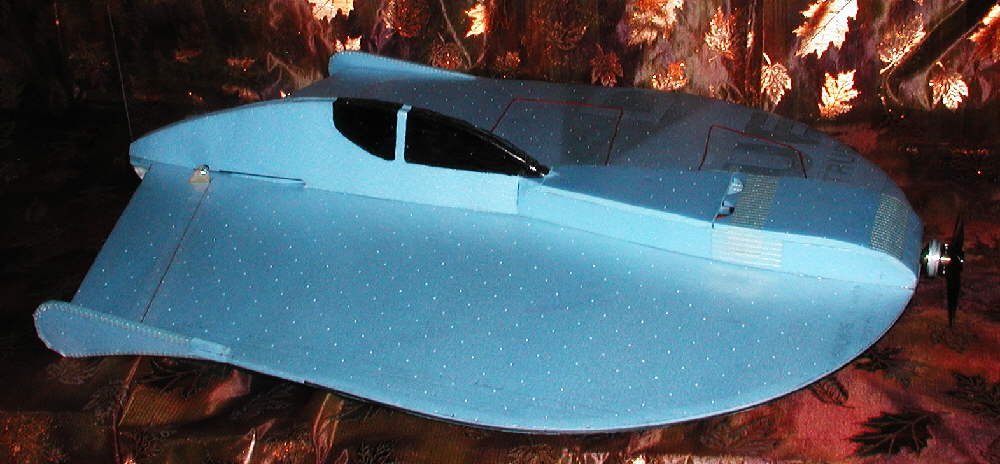
[BELOW]: Nose-on view showing inlet air vents; 1.5mm C.F. rod runs around perimeter of the disc.
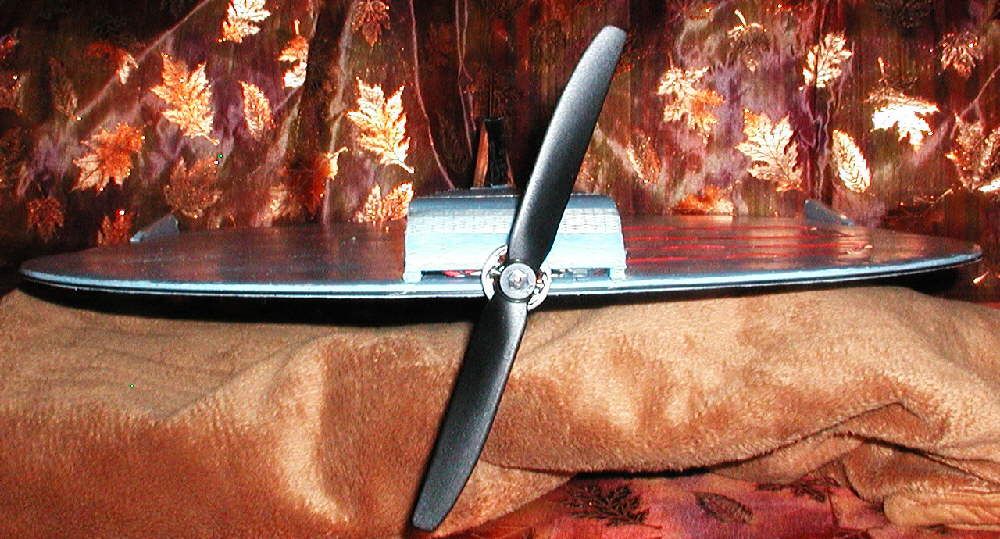
[BELOW]: Top of MANTA, showing the Equipment compartment, cockpit area; vertical fin is VERY clear! (Red wire is the receiver antenna.)

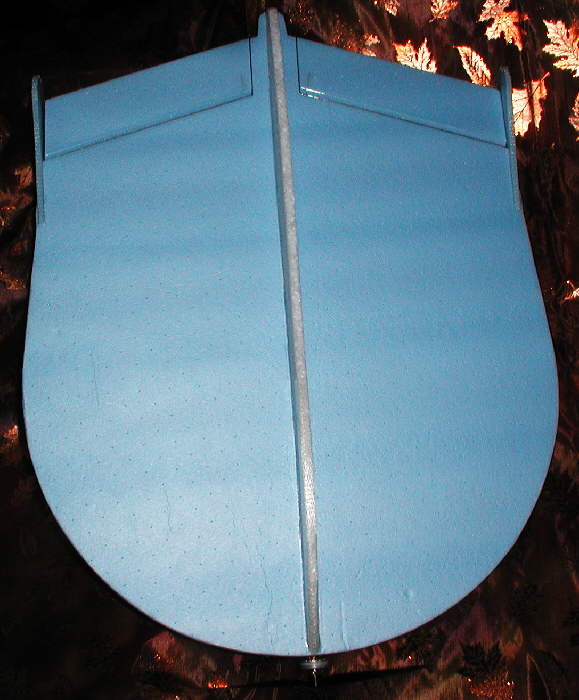
[BELOW]: Servos, receiver, & pair of 2S 850 mAH Li-Ion batteries under hatch; ESC is next to motor in front
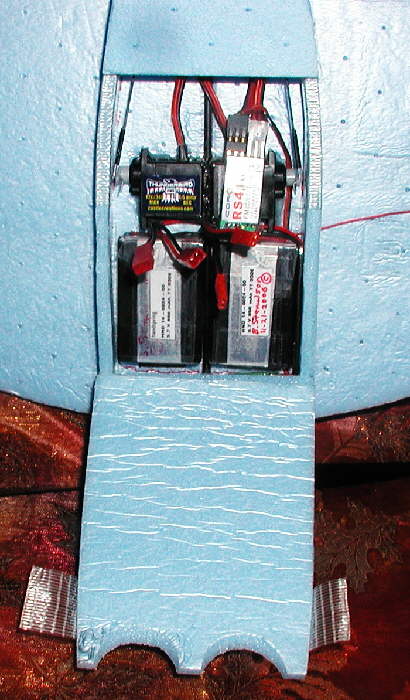
The Manta flew fine today; there is good authority from the motor & two paralleled 2S 850 mAH A&T Li-Ion battery packs, turning the 8x4.3 GWS RS prop. It looks great in the air! The vertical stabilizer fin definitely disappears. Even though winds were gusty & irregular, I just had to fly it!
It'll slow down to a hover, then climb out from that attitude easily. Elevon authority is very good; loops can be about as tight as roughly 4 foot diameter. Roll rate is very respectable, if not quite radical. The combination of the clear vertical stabilizer and the tip plates just off the ends of the elevons are very adequate for excellent stability.
Handling is good with the balance at 6-3/4" back from the front edge of the wing on this 20" wide, 24" long MANTA. It took the 3 ounces of the twin batteries to get the balance this far forward; (I'm expecting that balancing a double surface wing would become even more of a challenge!)
One of the most noticable flying characteristics about the flat plate wing (which I built without a cross- spar), is that there is a definite 'camming' as the wing switches from being loaded upwards, to being loaded downwards. Under full power / throttle, it's quite noticable as the wing transitions from up pitch to down pitch... enough so to motivate me to possibly add a C.F. tubular spar across the span of the disc to minimize this, to achieve smoother handling.
All in all, flying the MANTA promises to be a LOT of fun... and it does look cool & quite 'retro' flying by in the air... (that rear cockpit area's rounded, down-sweeping contour reminds me a bit of the back end of an early Corvette Stingray...
For beter visibility / definition, I added a set of 12 fluorescent orange 'windows' around the disc's lower front surface's perimeter. A photo of the resulting appearance is shown below. (This was partially inspired by the group of 6 UFOs actually seen flying by here one night in early October... all had yellowish-orange lights on their FRONT ends as they flew silently past... no other lights... still wondering about that...) Ah, life in the real South Park- always interesting!

The discussion inb the "USA UFO" thread, started by Glen P. Weber (GPW) on RC Groups, from the point where I started development of the MANTA can be checked out starting from this linked post; Thanks again, Glen & everyone who participates in this discussion thread, for the ongoing inspiration!
[November 28th, 2006] I'll offer a few dimensions for right now:
Construction was done with Foam-Safe ("No Odor")FLASH CyA glue and low temp hot melt glue. Some Scotch Extreme cross filament tape was used in a few selected areas for reinforcing, hatch hold-down & hinging, and the under-wing keel surface for landing durability.
My clear vertical fin is 5-1/16" high at the trailing edge; the lower edge, where it's mounted to the BlueCor with a pair of balsa triangle stock rails, is about 8-1/4" long.
My forward gear compartment is 11-1/2" long, with 15/16" high side wall pieces- it's covered above that height. It's a maximum of 3-3/8" wide on the outside dimension just behind the motor, tapering in to about 1-1/4" wide.
The rear cockpit panels are a maximuum of 2-7/8" high, and about 14-1/2" long, attaching into the rear of the forward gear compartment. At their widest spread at their base, they are set about 1-1/4" wide. They are glued to both sides of the clear polycarbonate vertival stabilizer fin with CyA, after having first been glued to the deck / wing with hot melt glue.
The wing cross-spar which I added, shown in the photo below, was glued in place with foam safe FLASH thin CyA late yesterday; it is 19-1/4" of 1/8" O.D. C.F. tube. I 'woodpeckered' with a T-pin through the surface film on the Bluecor on both sides of the tube to allow the thin foam-safe CyA glue to bond into the foam core, & weighted it in place while the glue set. The wing now has MUCH less flex, & should handle much better under full power.

DEcember 3rd, 2006 Flight Report
Manta flying; cold batteries drop off in performance
Sunday started off at around zero degrees in Colorado's high country; cooler yet in some places. But four of us got together to do some snow flying, & the MANTA had to fly!
I had added in the wing cross-spar since the last flying session, and I'll report that it definitely did reduce the pitch 'camming' noted between up-pitch & down pitch when flying at full power; but there is still some. This MANTA is definitely flying well; it's responsive, and well powered.
I'm flying a paralleled pair of the 2S Li-Ion 850 mAH packs built from the $.99 surplus cells. They are performing well.... but after about eight to ten minutes of flying, they were being affected enough by the cold air to be dropping off in performance... - (still quite a bit of capacity left.) They are definitely handling the current without warming noticably... which is less than ideal in cold winter flying conditions!
Late on the afternoon of December 6th, I got some time to work on the MANTA. The ESC is now isolated from the battery area, with it's own cooling air outlet vent. A new bulkhead was installed for the winter flying season, blocking off the excess cooling air flow that had been chilling the batteries and reducing their ability to perform dramaticly.
Manta's upper surface then gained some new windows around the forward perimeter. This trim compliments the smaller fluorescent orange windows on the lower surface, while at the same time offering excellent contrast and definition.
The radio receiver antenna was re-routed from it's earlier position, for a more balanced appearance.
The photo below shows the resulting appearance at this stage. I'm not sure what I'll add next for further trim; more later!

[Dec. 8th, 2006] My Manta is flying great; with the weight of the clear vertical stabilizer, it took the pair of 2S 850 mAH Li-Ion packs way up in the front to achieve balance- about three ounces of batteries, for a flying weight of 10-3/4 to 10-7/8 ounces. It has more area than a similar diameter UFO, modest wing loading, & excellent slow flight handling.
I'm looking forward to the arrival of the new LEDs, so I can get the night flying lighting system installed. (There are a lot of aircraft designs which I would NOT fly at night!!!)
By the way, I'm under the impression that the "Project Y" designation covered earlier designs, before the US Air Force funding was dropped in 1961, and the facility in Canada closed. The AVRO CAR, the hovercraft design, was a part of Project Y. The November 1962 Patent application by John Frost would, however, not have been a part of A.V. Roe's "Project Y"... it would have been a later design generation independently created by John Frost after that project had been closed down for about a year.
Originally Posted by gpw: "V60 ... well what in the heck are we gonna' call it ????"
So, if there are no other prior claims against, I'll hereby dub these renditions of John Frost's last November 1962 aircraft as the "MANTA Omega". (The Greek letter used for the Ohm sign seems appropriate, but I don't have that key on my keyboard, so I'll keep it simple & just spell it out...)
OK, I'm inclined to stay with the "MANTA Omega" designation for the Nov. '62 Frost design, since it was designed about a year after Frost left Project Y, and may have been his last design in this propulsion system approach. So the added "Omega" designation might be very appropriate.
The pointy nosed earlier version was labeled "AVRO V-T-O" in the two photos, from A.V. Roe's secret development project Y; it could be designated as that, (or as the "Manta Y") until more info comes to light to justify a change or further clarification.
[Posting on RC Groups as VIKING60]
Friends,
While waiting for my LED's to arrive, I was thinking of how thin flat plate wings (with lots of power) can be rather pitch- sensitive when transitioning form up-pitch to down-pitch attitude, and how the flexing in a wing can compound this quite extensively.
I decided to build out my second MANTA 'Omega' with some design features to minimize flex in the wing (far more than adding the 1/8" tubular C.F. spar had done on my first MANTA.) So I added another layer of Bluecor both on top and under the front portion of the wing, from about the C.G. forward, and rounded this 3/4" thick leading edge nicely. That stiffened up the wing, span-wise, very nicely!
Next, I followed GPW & Mike's approach of adding an elongated wing tip plate to further stiffen the wing & stabilize the slow speed handling even further. I made two sets of wing tip plates; one set of solid (opaque) Bluecor, and a second set contoured slimmer to try to keep the Frost design's side profile, but with more of the .030 thick clear plastic embedded in each wing tip for the added vertical stabilization.
The weight penalty for using the .030 clear plastic is about 3/4 ounce of added weight.... but the transparent disappearing wing tip fins still won out for their classic result.... (some trades ARE worth making...) [Now, I've GOT to find some .020 clear lexan for future projects!]
The results are shown in the photos below; airframe weight before adding the radio & propulsion system & any trim is at about 4-7/8 ounces. I'll report before long on how these design changes affect the flying characteristics... I'm looking for a very predictable night flying UFO !
[Dec. 11th, 2006] My MANTA is 20" wide, 24" long to the trailing edge of the elevons; I'm flying with the balance at 6-3/4" to 6-7/8" back from the front edge of the Bluecor.
My single layer one is quite flyable, but is pitch-sensitive when transitioning through neutral. I have not tried adding lead to move the balance farther forward, but that would be worth testing.
[Note: See later notes; better pitch stability is achieved when the balance was later moved forward to 6.4" back from the leading edge of the foam; this took 3/4 ounce of lead to test & verify, so building with weight / gear fully forward is likely the best approach!.]
My servos, dual 2S battery set (3 Oz.), and receiver are as far forward as I could build them... that clear tail fin way in the back does weigh a LOT compared to Bluecor... but I still love the look! [Gotta find thinner / lighter stiff clear plastic material suitable for those fins!!]
After the spar & trim, I'm flying at 10-3/4 ounces; 15 wind 25 ga. Y GBv 1.0 motor, 8x4.3 GWS slowflyer prop.
I'm expecting a lot less pitch sensitivity in the second Manta with the thick, rounded three-layer leading edge. The twin tail fins still add a substantial amount of weight far to the rear, so I'll again be installing gear as far forward as I can. I'll hopefully get to installing all of the gear and flying it by the end of the week; (I wound up another identical motor for this one, too, & will use the same battery setup.) I'll post a report of the flight test results.
Originally Posted by gpw: " And speaking of light ..... here's an example .... The Manta... I've given this alot of thought as how to lighten the rear of the plane ,making it easier to balance... I could go with lighter materials but that wouldn't be as crashworthy (it has proven it's toughness)... so what about less fins , etc... Maybe the top half of the side plates would be unnecessary , as well as the fronts of those fins/side plate... and the fuselage (under) doesn't have to be very much at all in the rear ..Perhaps a longer motor stick ???" [BKS Response Dec. 12th, 2006]: GPW, at what point, in reducing the vertical stabilizer / fin size, do you loose flight stability due to that aspect? Bluecor IS lighter by far than the clear plastic fins I've used, and keeping the weight down behind the center of balance is good.
Maybe adding battery weight way up front is still the main choice; My servos & receiver are also just as far forward as possible.
I'll have to fly Manta #1 for a flight with some extra weight in the nose, to see how moving the balance another ~1/2" forward affects the pitch sensitivity while transitioning through neutral pitch.... I HATE to add weight, but for testing purposes, I'll try it. (I still think wing flex is still involved to a larger degree.) If I need to switch to heavier batteries for optimum flight performance, then I can live with that! Flying weight is not at all an issue at this point; low speed handling is very good.
I'm still thinking, based on what I observed with the HOOT I built with the doubled thickness wing leading edge, that much of the pitch sensitivity has to do with the wing's thin sharp leading edge. (Most of the rest comes from wing flex or 'camming' from being loaded UP while climbing, to rapidly transitioning to being loaded DOWN when down elevator is applied.) Doubling or tripling the Manta #1's leading edge is still another possible option which would add a bit of forward weight while also adding thickness and stiffness.
That's the nice thing about foamies- implementing & testing modifications is relatively easy!
VIKING
[Dec. 16th, 2006] I'll hopefully get a chance to fly the thickened & very stiff wing on my #1 MANTA tomorrow- (I did the same modification on it that was built into the second Manta, tripling the thickness of the wing's leading edge.) Wing loading is now at 4.3 ounces per square foot, and the extra ~1/2 ounce of Bluecor, hot melt glue, and trim also moved the balance forward some. Flight report soon!
[Dec. 18th, 2006] Manta Flight Report
I flew the Manta #1 (with the recently modified triple thickness front wing section) on Sunday. Winds were strong & air was turbulent with blowing snow, but the Manta handled it OK. It was fun and exciting flying, but not anything any of the spectators would characterize as 'relaxing' flying!
It does still have a fair amount of pitch sensitivity when transitioning through neutral pitch, even after adding the extra layers to thicken & stiffen the wing, so there's more to the story to be understood. In contrast, My HOOT, with the doubled Bluecor leading edge (second layer on top), is not pitch- sensitive in the same manner- it handled the turbulent windy air without problems.....
I'll simply start adding lead inside the nose compartment on top of the pair of flight batteries, and see how progressively moving the balance farther and farther forward affects this handling anomoly. GPW's comments lead me to thinking that this is still the key to further taming the Manta's flight characteristics.
Manta certainly does fly, loop tightly, roll tightly, and go into high alpha attitude easily, and does torque rolls, etc.... but that quick pitch transition from up pitch to down pitch while not easily staying in a neutral / level pitch attitude would not be so easy or comfortable for novice flyers to handle... The shorter UFO evidently does not have this tendancy when the balance is in the correct forward position, so I'm thinking that the Manta's balance is still simply too far back.
VIKING
An absolute necessity for good cold weather / winter flight performance!
While doing a bit of Christmas shopping in Target a couple of weeks ago, I noticed something of interest- it's a modest sized 12 volt powered cooler / heater, nicely insulated, and has enough room inside for about nine cans of soda, etc. It used a solid state Peltier Junction heat pump to either cool or HEAT the interior, drawing about 4.8 amps while doing so. (The controls have it cycling on & off for about a 50% duty cycle, so it's power consumption in the heating mode is roughly 3 Amps per hour- not too hard on a car battery or 17 Amp-Hour Gell Cell battery in a portable jumper Power Pack.)
I left the house with the cooler fairly well packed with about 15 to 20 pounds of battreries at cool room temperature, and plugged in the 12 volt power cord while driving for ~ 1-1/2 hours to get to the Christmes party / Flying session. By the time I was ready to fly, the batteries were at close to 100 degrees F or a bit warmer, very happy & ready to do their thing!
I kept it plugged in & powered throughout the flying session, and was flying with batteries that were pleasantly warm to the touch before each flight started. The difference from flying with chilled batteries was very noticable in the power that the warm batteries could offer!
The price tag? Price now reduced from $30 to $25 for the Cooler, a 12 volt car cord, ***AND a very nice 4.8 Amp, 13.8 volt switching power supply*** for running from AC power in the house, etc. This power supply has a corded cigarette lighter jack on it; when not powering the cooler / heater (battery warmer) from 120 VAC, it would serve as a very good power supply in the house for powering your flight battery charger! (Have you checked out the normal price of well regulated switching mode power supplies with this rating? They are not very cheap...)
No more flying with chilled batteries for me- Hurray!!!
[Dec. 19th, 2006] Manta needs forward balance position
GPW wrote: "the only thing that really cured the tucking was moving the cg and using a bit of positive elevon trim (elevons Up in the rear)...It now flies quite happily with a slight nose Up attitude..."
I'm still balanced at close to neutral elevon trim, and while it's very flyable, I'm planning to push the balance forward a bit more to see how it affects everything; the positive elevon trim does make a LOT of sense in obtaining greater pitch stability! Time to test fly it when the weather allows.
Mine lands quite predictably already- not a problem there, but I "flirt with the dirt" a lot when flying - lots of very low altitude aerobatics, so the pitch sensitivity when going from up pitch to down pitch will have you keeping your attention on the aircraft. I'm not ready to put the night flying lights on it yet until I push the balance forward a bit more & tame down that sensitivity.
The 20" wide by 25" long overall size (including the cockpit tail extension) is a good size for carrying the weight of the larger batteries (& larger motor?) which make balancing a Manta easier; 4.3 ounces per square foot is still fairly light in my book, & the Manta will slow way down, then climb out vertically from a hover... This really IS a COOL looking aircraft when it's flying!
VIKING
[GPW commented:] "V60, Thanks for the info !!!! Try the + Elevon, I think it will work for you ....the stability becomes a balance between the wing /noseweight want to pitch down vs. the reflex in the elevons trying to push the tail down .... like a see saw...fat kid goes on the front
Your bigger Version sounds like the better way to go for more power.... Wl is still ultra light ...any plans for plans ??? or do you really think anyone else would want to go through this ....??????hahahahahahaha"
People" freak out " here when they see it fly , cars stop , question .... What in the heck is that ??? Totally alien looking hovering around so slowly ..... FUN !!! Yeah , they'll want one ...." F
riends,
I had a chance to fly the MANTA with some added weight in the front end; on my build (20" wide, 25" overall length, heavier center clear fin) I added 3/4 ounce of dead weight on top of my flight batteries to get the balance at 6.4" back from the leading edge of the foam disc.
With the balance at this 6.4" back point, there are **NO** hints of the pitch sensitivity which I was still seeing when the balance was at 6.7" back from the leading edge; (this was what GPW had been referring to as a tendancy to "Tuck" when the balance on his was too far back.)
(I had also flown it with the balance even farther forward, and it was very stable.) But it's ideal maximum rearward limit for the balance seems to be at from 6.4" (to maybe 6.5") back from the center L.E.
With the balance here, it's a real sweetheart, - Very predictable!
On a windy day, a more forward balance might still be able to handle gust buffeting more smoothly, so novice pilots should consider this...
If you jump into building one of the MANTAs, keep the back end as light as reasonably possible, and install your servos & receiver as far forward as possible while planning to be able to mount your flight battery at the front center as necessary; this will allow flying with a light weight battery and still achieveing your desired balance.
Tripling the front 6.5" of the leading edge results in excellent rigidity span-wise; the wing side plates that Mike Smith & GPW initially implemented offer good resistance to flexing front-to-back... all without adding ANY C.F. or Bamboo! The much thicker rounded triple thickness leading edge does the final trick on reducing pitch sensitivity which you might otherwise see with a thin single surface leading edge. With these details implemented and the balance in the right place, MANTA flies as COOL as it looks! (Photo of my Manta #1 below with the tripled thickness leading edge, and the Omega graphic addad, along with the re-done 'windows'.)
Friends,
Getting the balance far enough forward was definitely the trick on my Manta; it's flying manners are great now, the pitch sensitivity is completely gone, high speed handling & roll response are very good, and I can chop throttle on landing approach, hold it in a slightly nose high attitude, and glide in to a gentle touchdown on the rear end of the belly skid and rear elevon-tip end plates easily & consistently. (What a difference finding the 'sweet spot" on the balancing can make!)
I'll be finishing out my MANTA #2 before long now; it has the clear vertical stabilizers built into the wing tip plates, and no center vertical stabilizer.... I confess that I also cheated a bit on the 'scale' dimensions, as I was using the remains of the sheet of Bluecor left after cutting out Manta #1, so the back end is shortened by about 1-1/2" to a overall length of 23-1/2", while the width is still at 20")
Below is a photo of Manta #1 after the last modifications of tripling the leading edge area; I re-did the graphics after that, adding more of the 'windows' to both top and bottom. It has good visibility / definition / contrast from top to bottom. (It even got it's "Omega" graphic added at the rear of the cockpit area!)
Below: Two Mantas out for a day of flying Friday Jan. 19th was finally warmer after weeks of high winds & snow storms; only light breezes, & sunny... a perfect excuse to set aside the work for a little while, and get out and fly this afternoon for a while!
The MANTAS are both flyingh great!. I found I had to fly the newer MANTA (Black & yellow top) with a heavier battery / balance shifted farther forward than I had thought I would; I had it flying very fine with 3-1/8 ounces of battery & lead way forward. Since this is exactly the weight of the pair of 2S 850 mAH Li-Ion batteries that I have been flying in the Blue MANTA, the result is obvious- to set up to fly MANTA #2 with the same batteries! That puts this one flying very responsively at 11-3/8 ounces. Without the clear vertical fins, it's far easier to balance a MANTA or ARROW with much lighter battery packs; GPW has proven that nicely!
The MANTAs can move out, but they also slow way down in high alpha attitude, and land very nicely & predictably. At higher spered, the rolls are nicely axial and the roll rate is very good; like the HOOT, you can actually get them into an inverted flat spin, then easily fly out of it again. Oh- and the MANTA will loop in about it's own length when the throttle's up... lots of fun to fly!
And they really DO look too COOL flying by!!
Here's a closeup view of the battery mounting compartments on the underside of the MANTA; there are now two, one on either side of the EPP underbody, which extend most of the way through the triple layers of Bluecor towards the top surface. (I needed the weight of the two 2S 850 mAH packs to bring the balance farther forward, and having the weight distributed equally laterally should help in slow speed flight handling. These packs weigh 44 grams each- good energy density.)
Scotch 'Extreme' cross-filament nylon filament tape overlays the area, before light clear plastic covers are taped in place. The purple trim was then added to dress it up; it's the colored packaging tape from http://www.Fastpack.com.
I started out flying a pair of surplus cell 2S 850 mAH Li-Ion packs which I built up; they are connected in parallel, so each sees a maximum static current draw of about 4.2 amps.
(This is flying with a 15 wrap Y GBv kit brushless motor, turning a GWS 8x4.3 prop.)
UPDATE NOTE: While these batteries fly the Manta Omerga OK, they have far more of a voltage drop under load at this current draw than LiPoly battery packs. I find that I have far better flight performance when flying a pait of LiPoly packs.
On the Manta "ACE", I've chosen instead to design a high stability aircraft with large wing tip plates that work not only as vertical stabilizers, but also work as dual wide stance tail skids in conjunction with the single forward wheel, to provide excellent ground handling for both takeoffs and landings. This also offers excellent protection for the propeller and motor.
The elevons are sized nicely to provide excellent control. The upper and lower profile fuselages were designed to both add to the visual impression of a "UFO" inspired craft, as well as to contribute to the structural stiffness in the longitudinal direction.
After having the second Manta Omega prototype come in at a flying weight of 11-3/8 ounces, I decided to use the extended pointed nose profile on this rendition of the ACE to locate the motor and flight battery farther forward from the ideal CG point. The wing is made from a single layer of 6mm foam that was purchased from BPHobbies back in 2006; it has a white foam core with a plastic surface film on both top and bottom. It has enough rigidity so that no span-wise spars were required.
Equipment used: 24 gram brushless "Blue Wonder" motor, 1300kV rated; 12 Amp Brushless ESC, and two HXT500 servos. On 2S batteries, I'm flying a GWS 9x4.7 Slow Flyer propeller.
The flight performance, stability, and the aerobatic handling are beyond design expectations; it's a smooth flyer from the rollout and takeoff to the very slow and managable landings. The rolls are very axial. The ACE can be flown nicely in a very limited amount of space, so it should work very well as an indoor flyer.
Using a 10x3.8 prop might also allow irreverently slow maneuvering while maintaining excellent thrust in indoor & outdoor slow flying situations. Conversely, changing to an 8x5 or 8x6 propeller should kick up the top speed, and the roll rate as well. Theswe options will be tested as time allows
While the total wing surface area is similar to that of the 'Manta Omega' designs, the ACE is built at 2/3 of the weight / wing loading. This results in an aircraft that handles superbly at low speeds in a limited amount of airspace. It's incredibly stable, yet responsive.
The Manta ACE would be an *Excellent* night flyer- it's that stable and predictable! I'll add information on the added light systems if & when I add them to this design.
My 2nd MANTA 'Omega' shaping up


A cure for the chilly battery situation
KEEPING BATTERIES WARM-
[Dec. 22nd, 2006] Manta Balance- when it's far enough forward, pitch sensitivity is ELIMINATED!
HURRAY!!!


MANTA #2 Ready for flight! Flying weight with 2S 800 mAH LiPoly = 9-7/8 ounces.





Twin Battery Compartments added on MANTA #2
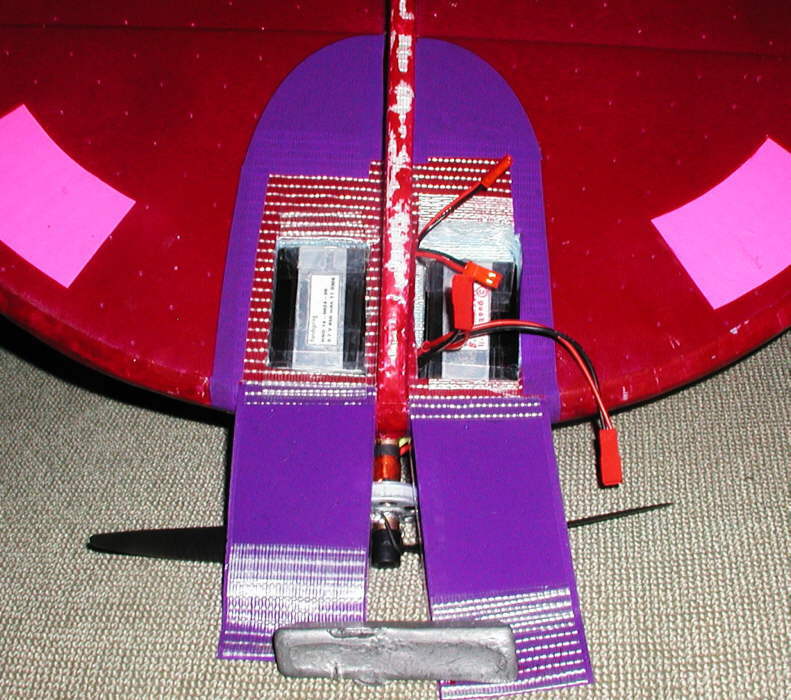

The prop should unload some in the air, so that the current draw on each pack is just under 4 amps at wide open throttle while flying. These Li-Ion packs seem to be performing fine at this current, and show only very modest warming at the end of a flight. With 1700 mAH of total capacity for the two paralleled packs, long flights are possible... I never have run the packs down to the cutoff so far.
Both of my MANTAs, with the .030 thich clear plastic vertical stabilizers, look cool in the air, but do end up needing the heavier battery packs up front to balance properly for smooth flight performance. It'll be nice to have a new lightweight craft in the hanger for indoor flying! The MANTAS do not mind the weight at all, however, and fly great outdoors! They don't mind flying in the winds- which is a very good attribute up here in South Park!
This lightweight foamie design is only loosely inspired by John Frost's design, as shown in the first two photos below. Glen Weber and Mike Smith have also previously built their own stylized renditions of this example of John Frost's design work. This one is my own approach, drawing on all of the prior 'inspiration', along with my own design perspectives.

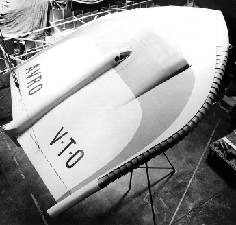
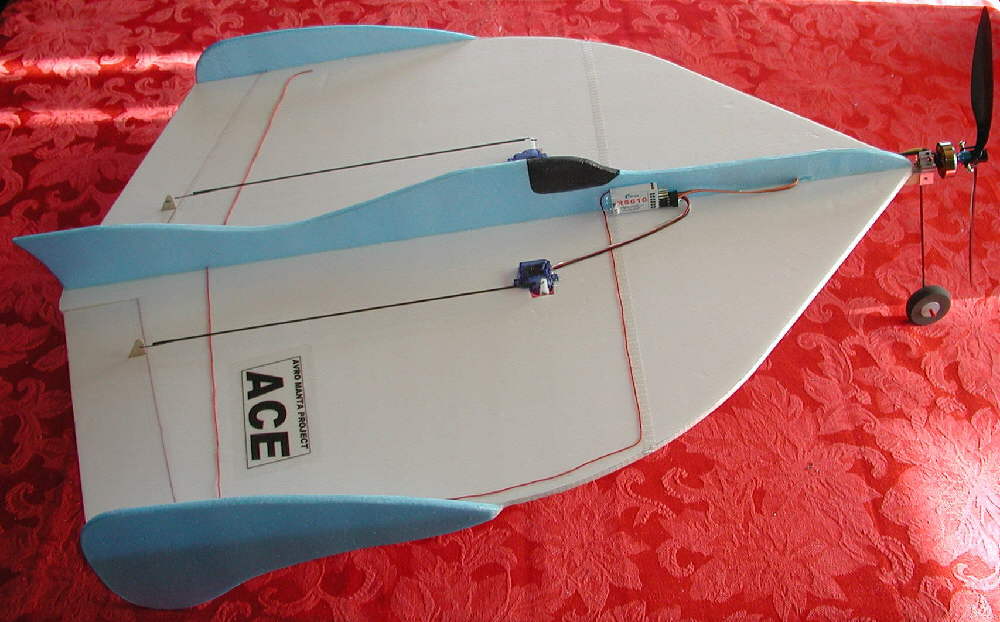





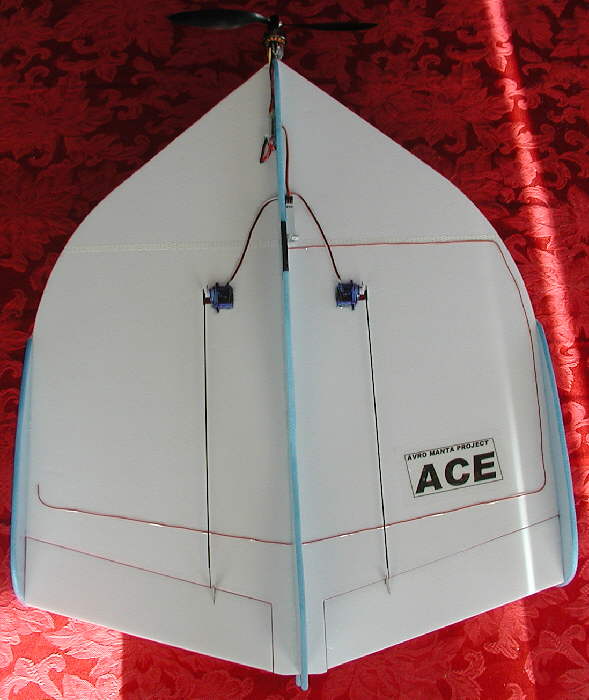
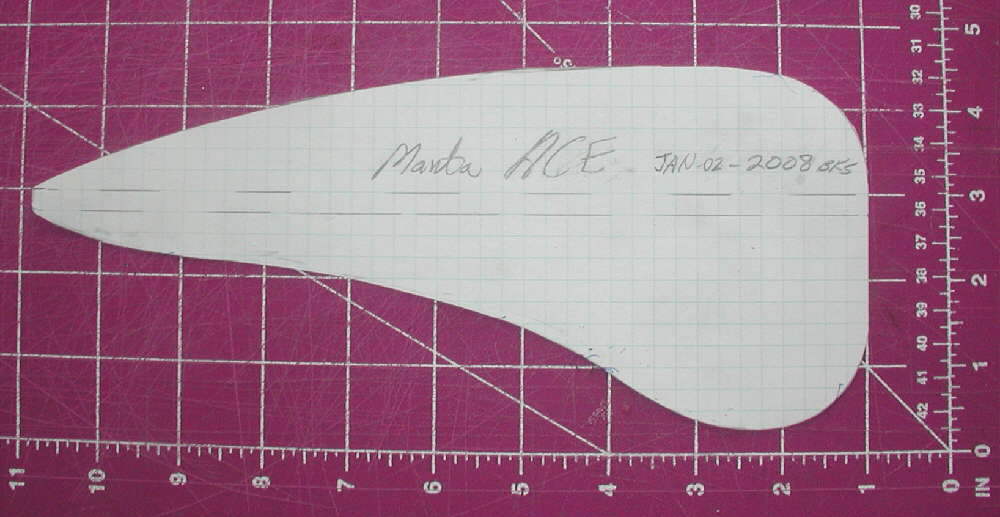
This web site and all of the digital photos and other original materials found here are subject to protection under the Copyright laws; All rights are reserved by Bruce K. Stenulson, P.O. Box 69, Fairplay CO. (c) 2004-2008. Permission is granted to link to this web site or to it's individual pages, but not to reproduce any materials found here for other than personal, non-commercial use. My intention is to maintain the context within which this material has been presented.Thanks for your understanding.